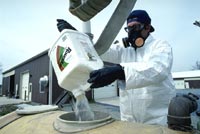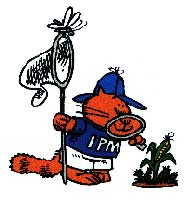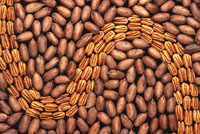


| Categories 1, 4, 10,12 | |
|---|---|
| February 27, 2004 | Fayette Co. Extension Office |
 The 2004 IPM Training School has been scheduled for
Wednesday, March 17. The meeting will be held at the UK
Research Center in Princeton. Registration will open at
8:30 AM with the meeting starting at 9:00AM and ending
about 3:30 PM. Advance registration is not needed and the
meeting is open to the public free of charge. Program will
apply for CEU's for Certified Crop Advisers and hours for
Kentucky Pesticide Applicator Training.
The 2004 IPM Training School has been scheduled for
Wednesday, March 17. The meeting will be held at the UK
Research Center in Princeton. Registration will open at
8:30 AM with the meeting starting at 9:00AM and ending
about 3:30 PM. Advance registration is not needed and the
meeting is open to the public free of charge. Program will
apply for CEU's for Certified Crop Advisers and hours for
Kentucky Pesticide Applicator Training.


![]() In 2003, an estimated 30,000 acres of soybean in
Kentucky were treated during early- to mid-pod
formation (R3 to R5) with a single application of
Quadris fungicide (6.2 fl oz/A) + Warrior insecticide
(2.56 fl oz/A). This represents a major change in how
soybean is produced here, since almost no fungicides
and very little insecticide have been applied to soybean
over the past 20 years. Activity in 2003 was the result of
a "guarantee program" initiated by the chemical
manufacturer, Syngenta. This program did not target
any specific insect or disease pests, and was based solely
upon an observed +6.85 bu/A average yield response to
the treatment in 13 grower fields in southern Indiana
and Kentucky during 2002. The cost of applying 6.2 fl
oz/A Quadris + 2.56 fl oz/A Warrior is about $23/A,
assuming a $4/A cost for application.
In 2003, an estimated 30,000 acres of soybean in
Kentucky were treated during early- to mid-pod
formation (R3 to R5) with a single application of
Quadris fungicide (6.2 fl oz/A) + Warrior insecticide
(2.56 fl oz/A). This represents a major change in how
soybean is produced here, since almost no fungicides
and very little insecticide have been applied to soybean
over the past 20 years. Activity in 2003 was the result of
a "guarantee program" initiated by the chemical
manufacturer, Syngenta. This program did not target
any specific insect or disease pests, and was based solely
upon an observed +6.85 bu/A average yield response to
the treatment in 13 grower fields in southern Indiana
and Kentucky during 2002. The cost of applying 6.2 fl
oz/A Quadris + 2.56 fl oz/A Warrior is about $23/A,
assuming a $4/A cost for application.
In 2003, we did a great deal of work to discern if the apparent yield increase could be repeated in replicated studies and, if so, where Quadris + Warrior might fit in Kentucky soybean production. Specifically, we implemented two replicated small-plot studies at the UKREC in Princeton. Both studies included treatments of Quadris or Warrior alone and in combination, and compared them with a non-treated check. One test also included applications at three soybean growth stages (R3, R4, R5). In addition, we implemented three large- scale, replicated strip tests in grower fields and collected data from six grower fields that had been treated with Quadris + Warrior, but where non-treated check blocks were left. Finally, we summarized yield data from 51 non-replicated grower trials across west Kentucky. A portion of our 2003 data is presented below.
Overall, we found that defoliation was delayed by about one week in most tests when Quadris was applied by itself or in combination with Warrior. In most fields, we also found that these same treatments reduced stem anthracnose by about 40 to 50%. Control of pod anthracnose was highly variable across all tests. Neither defoliation nor stem/pod disease were affected by Warrior application.
In the two small-plot studies, no significant yield increases were found when Quadris or Warrior was applied alone, or when the combination was applied at the R3 or R5 stage (data not shown). However, in both tests Quadris + Warrior applied at R4 significantly increased yield compared to the check (Table 1). All this was true in spite of the fact that Quadris alone and Quadris + Warrior both reduced percent defoliation and percent stem anthracnose. Foliar disease and insect pressure were extremely low in both studies, so these cannot account for the observed yield effects.
Table 1.
| Yield Results from Two Studies UKREC, Princeton, KY, 2003. | |||
|---|---|---|---|
| Yield (bu/A) | |||
| Treatment* | Rate/A | Study 1: A3703: 42.2bc** | Study 2: P94B74: 66.0b |
| Non-treated | -- | 42.2bc** | P94B74: 66.0b |
| Quadris | 6.2 fl oz | A3703: 40.1c | P94B74: 68.5ab |
| Warrior | 2.56 fl oz | A3703: 48.2ab | P94B74: 68.3ab |
| Quadris + Warrior | 6.2 + 2.56 fl oz | A3703: 51.0a | P94B74: 70.8 |
*Treatments applied at the R4 stage.
**Means within a column with a common letter are not significantly
different
Ryan's-Q, P = 0.05
Across 51 non-replicated field trials (Table 2), yield response to an application of Quadris + Warrior ranged from zero bu/A (net loss of -$23/A; i.e, the cost of the product plus application) to a high of 12.1 bu/A (net gain of +$77.19, assuming a soybean price of $8.28).
Table 2. Distribution of Yield Results for Quadris + Warrior Application in 51 Non-Replicated Field Trials, KY, 2003.
| Yield Range (bu/A) | Number of fields |
|---|---|
| 0 or less | 2 |
| +0.1 to 2 | 9 |
| +2.1 to 4 | 12 |
| +4.1 to 6 | 12 |
| +6.1 to 8 | 11 |
| +8.1 to 10 | 3 |
| > 10.1 | 2 |
*Significantly higher than non-treated yields; locations
treated as replications,
ANOVA, P = 0.03
In Summary:
So, what is going on? To be honest, we do not know. If yield increases were the result of delayed defoliation and/or to stem disease control alone, we should have seen the same yield response regardless of whether Quadris or Quadris + Warrior were applied. We did not. Also, of the eleven fields we scouted on a weekly basis, there was not enough foliar disease or insect pressure to account for any yield differences in any of fields. At present, we can offer no explanation why adding Warrior to Quadris would bump up yields in the absence of any obvious insect activity. It is fairly well known that strobilurin fungicides, like Quadris, incite a so-called "greening effect" in treated plants that is unrelated to pest control. It is possible that Quadris + Warrior, but neither pesticide alone, may sufficiently alter plant physiology so that higher yields are promoted.
Clearly, there is a great deal more work that needs to be done. Even with the data that we currently have, we are still fine tuning our analysis to look for interactions. This is definitely a "work in progress". Plus, we have only been discussing a single year's results. Nonetheless, the yield results look promising enough that you might consider testing the treatment on a limited acreage basis in 2004. In the meantime, we will be repeating most of the work we did in 2003, as well as conducting some additional studies. We all have an interest in identifying situations most likely (and least likely) to show an economical response to Quadris + Warrior.
For more information about soybean pests, visit
"Insect Management Recommendations".


Peach leaf curl disease, caused by the fungus Taphrina deformans occurs on peaches, apricots, and nectarines in Kentucky commercial orchards as well as in home landscapes. A similar, but less common disease, plum pockets, caused by the fungus Taphrina communis, occurs on plums. These two diseases are easy to control with a single fungicide application, but a spray needs to be applied now, while the trees are still dormant.
Symptoms. Peach leaf curl is easily recognized in late spring by the thickened, folded, puckered, and curled leaf blades. These symptoms may be present on the entire leaf or just on parts of the leaf. Infected leaves or parts of leaves soon acquire a red or purplish coloration, making them especially conspicuous. In some cases, nearly every leaf on a tree may be infected. The diseased areas develop a powdery gray coating (fungal spores) and leaves may then turn brown, wither, and drop from the tree. Yearly defoliation resulting from peach leaf curl can seriously weaken the trees. Trees free of disease will bear better crops and withstand other diseases and environmental stresses more successfully.
Plum pockets disease symptoms are very obvious; infected fruit become distorted and much enlarged. With spongy or hollow centers, these malformed fruits are sometimes referred to as "bladder plums," "mock plums," or "plum pockets." Deformed fruits eventually turn brown or black and fall from the tree. Leaves and tips of plum pockets-infected shoots appear swollen and are often twisted and curled.
Disease spread. Spores produced on infected leaves in the spring and summer are spread to all parts of the tree by wind and rain and spores of the fungus, in a different form, become lodged under the bud scales and rough bark. The fungus remains there throughout the summer and winter months until the next spring infection period. In spring, when peach buds begin to swell, germinating spores of the fungus penetrate the developing leaves, causing leaf curl infection. Twig and fruit infection, which is less conspicuous, can also occur. Leaf curl is more severe when early spring weather is cool and wet. Rain is essential for disease to occur; good control can be obtained on a small scale by erecting a plastic umbrella over the tree from late winter to spring. The plum pockets disease cycle is similar to that for peach leaf curl. Infected wild plums may serve as a source of inoculum.
Disease management. To control peach leaf curl and plum pockets, a single fungicide application, if it wasn't already made in the fall, can be made between now and when the buds swell in early spring. However, as soon as the buds swell in spring, it is too late to apply the fungicide, so depending on the weather, we may have only a few weeks left to control these diseases. Fall is usually a better time to spray for leaf curl or plum pockets because the weather is dry and it is easier to move equipment through the orchard. In addition, peach and plum buds sometimes begin to swell during mid-winter thaws leaving the grower no chance to control the disease in early spring. Fungicides will not control peach leaf curl or plum pockets once buds begin to swell in spring and infection has occurred.
The choice of fungicides for dormant sprays include
chlorothalonil (Bravo); ferbam (Carbamate); Ziram; or
fixed copper fungicides such as copper hydroxide
(Kocide), copper oxychloride (COCS), or Bordeaux
mixture. Thorough coverage of the twigs and branches
is essential. For further information on stone fruit
disease management,
consult U.K. Cooperative
Extension publication ID-92, 2004 Commercial Tree Fruit
Spray Guide, available from County Extension Offices
statewide.


Insignia 20WG® fungicide recently received a federal label (and the necessary approval from the Kentucky Department of Agriculture) for use on golf course turfs for disease control. Insignia contains the active ingredient pyraclostrobin, which is a member of the strobilurin (QoI) class of fungicides. Turf managers should note that Insignia is labeled only for use on golf course turfs.
As is typical of the strobilurin fungicides, pyraclostrobin is effective at low use rates and has low mammalian toxicity. Because of these and other favorable features, the U.S. Environmental Protection Agency considers it a "Reduced Risk" pesticide. Strobilurin fungicides typically are toxic to highly toxic to rainbow trout and Daphnia magna (water flea), which are indicator species of toxicity to aquatic ecosystems. Among the strobilurins, pyraclostrobin is particularly toxic to rainbow trout. Thus, it will be important to use the product carefully to avoid contamination of streams, ponds, and lakes. Some guidelines for minimizing the risk of contamination are available on the label. One factor that will help reduce risk to aquatic ecosystems is pyraclostrobin's very strong ability to bind to organic matter in leaves and thatch. The binding ability of pyraclostrobin is the highest among the range of turf fungicides to which I compared it. This strong binding to organic matter will also help minimize leaching potential.
Pyraclostrobin is strongly lipophilic, which means it binds tightly to the waxy cuticle of turfgrass plants. It is not a systemic; pyraclostrobin simply moves across the leaf blade from the treated leaf surface to the other surface. Thus, applicators should strive for thorough spray coverage to get the most out of this product.
Pyraclostrobin has a rather broad spectrum of activity against fungal pathogens of turfgrass, as reflected by the wide range of diseases on the label. In preparation for writing this article, I searched the literature available to me and found 52 scientifically valid research reports which included Insignia. As always, my principal source was the journal Fungicide and Nematicide Tests, although other published reports were used when available. I evaluated the efficacy of the product in the 52 reports and have summarized the results in the accompanying table. These efficacy ratings are based on the best information available to me at the time of publication; ratings may change as new information becomes available.
| Disease (Pathogen) | Efficacy of Insignia(a) |
|---|---|
| Anthracnose (Colletotrichum graminicola) | ++ |
| Bentgrass Dead Spot (Ophiosphaerella agrostis) | L |
| Brown Patch (Rhizoctonia solani) | ++++ |
| Dollar Spot (Sclerotinia homoeocarpa)(suppression only) | ++ |
| Fairy Ring (various basidiomycete fungi) | L |
| Fusarium patch (=Microdochium Patch)(Microdochium nivale) | +++ |
| Gray Leaf Spot (Pyricularia grisea) | ++++ |
| Gray Snow Mold (Typhula incarnata) | NA |
| Leaf Spot (Bipolaris, Drechslera, Exserohilum) | L |
| Melting Out (Drechslera poae) | L |
| Pink Patch (Limonomyces roseipellis) | L |
| Pink Snow Mold (Microdochium nivale) | +++ |
| Pythium Blight (Pythium aphanidermatum, Pythium spp.) | ++ |
| Rapid Blight (Labyrinthula spp.) | L |
| Red Thread (Laetisaria fuciformis) | ++++ |
| Rust (Puccinia and Uromyces spp.) | +++ |
| Summer Patch (Magnaporthe poae) | L |
| Take-All Patch (Gaeumannomyces graminis var.avenae) | +++ |
a Rating system for fungicide efficacy is as follows:
++++ = consistently good to excellent control in published experiments
+++ = good to excellent control in most experiments
++ = fair to good control in most experiments
+ = control is inconsistent between experiments, but performs well in some instances
= no efficacy
L = limited published data on effectiveness
NA = not applicable to Kentucky
Based on the available data, it is clear that Insignia has excellent activity against brown patch and gray leaf spot. It also appears to be very useful for control of pink snow mold/Microdochium patch, red thread, and take- all. In a single test for each disease, Insignia performed very well against leaf spot, leaf rust, and summer patch; however, one test is not enough to make a judgement as to efficacy. Performance against anthracnose, dollar spot, and Pythium blight has been erratic in published tests. While it performed well against these diseases in certain tests, efficacy has been too variable for me to suggest that this product can be used alone against these diseases. I should note that the Insignia label only claims "suppression" for dollar spot, and it recommends tank-mixing with another effective dollar-spot fungicide under moderate to severe dollar spot pressure. I'll also note that there is no single product that consistently controls anthracnose.
Insignia has a single, very specific biochemical site of action in the fungal cell, which it shares with other strobilurin (QoI) fungicides. Since resistance to these fungicides has occurred rather quickly in certain fungi, including the gray leaf spot and anthracnose fungi in turf, the potential for resistance to pyraclostrobin is high. In fact, in locations where resistance to strobilurin (QoI) fungicides is known to occur, there will be generally no value in using Insignia to control that disease. (There may be occasional exceptions to this statement, depending on the particular resistance mutation present at the site, but these exceptions are not expected to be common.) Given the high risk of resistance to pyraclostrobin, I strongly recommend that users be familiar with the section in the label on "Resistance Management.
Users should also be aware that there is a seasonal
maximum of 5.5 ounces per 1000 sq. ft (15.0 pounds per
acre) that may be applied each year.


Holes in pecans and chestnuts and legless white grubs
crawling around in the storage containers is the end
point of events that occurred back in the summer. While
the is not much to be done for the weevils now, there
are steps to take to manage these insects in home
landscapes and orchards. A fact sheet on nut weevils is
available on line at
http://www.uky.edu/Agriculture/Entomology/entfacts/fruit/ef206.htm

NOTE: Trade names are used to simplify the information presented in this newsletter. No endorsement by the Cooperative Extension Service is intended, nor is criticism implied of similar products that are not named.
Lee Townsend
Extension Entomologist